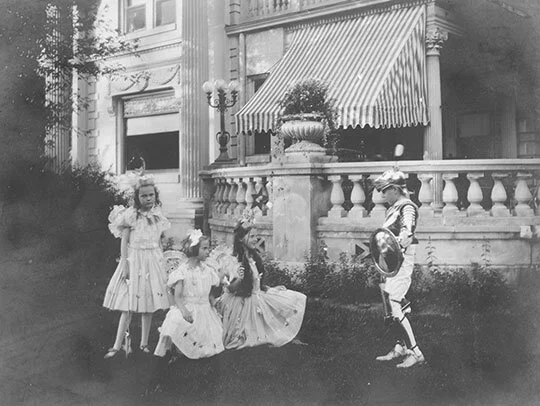Once I Saw a Fairy...
Are you heading out to Faeries, Sprites, & Lights tonight? If you can’t find the time this evening, come by tomorrow or Saturday to experience the wonder and magic of Oakhurst—a place where Elisabeth “Betty” Ball’s youthful imagination was able to explore the world around her.
If you’ve attended the event before you may have heard stories of Betty’s love of, and interest in, fairies. Born in 1897, Betty grew up at a time when fairies dominated popular culture. It is no wonder then, that these fantastic creatures captured her childhood imagination, and often made appearances at her garden tea parties or during her make-believe play.
Helen Ball with her cousins Margaret, Lucy, and E. Arthur Ball (L to R). The children are dressed as fairies and a knight – likely for a party held at Minnetrista, the home of Frank C. Ball, between 1900 and 1905. Minnetrista Heritage Collection
In the decades before Betty’s birth, books like Grimm’s Fairy Tales and The Fairy Tales of Hans Christian Andersen became so popular that the genre grew leaps and bounds. By the early 20th century children’s books were filled with countless stories of the strange and wonderful. Elves, sprites, gnomes, and fairies were featured in lavish illustrations that at times seemed to jump right off the page. In fact, fairies were so popular that their depictions could often be found on wallpapers, lamps, and in artwork hanging in galleries across the country.
Around 1904 Betty read Alice in Wonderland. In the tale, Alice enters a world where fairy and elf-like creatures live freely. A few years later she devoured stories such as Out-Door Land, Forest-Land, and Garden Land—a series featuring talking animals and insects. When she read Peter Pan, the character of Tinker Bell took on human emotions such as happiness, anger, and jealousy; making her relatable to readers of all ages.
Elisabeth “Betty” Ball in a fairy costume around 1902.Minnetrista Heritage Collection
As Betty grew up, so did her interest in fairies. The mysterious creatures that had once played roles in her games of make-believe became topics for her poetry. She depicted them as friendly and dancing, mysterious, and existing somewhere between the reality of fireflies and the musical sound of the breeze. Her poem, “The Sunset Fay” even seems to depict a fairy that may have been inspired by Tinker Bell herself:
On the edge of a rose-gray cloudlet
Against a golden sky
A little fay was standing
On tiptop, with head high.
Her filmy garment blew behind
As slowly she rose in flight.
She flew toward the fading sunset
And a star appeared in the night.
Having seen the play, and read the Peter Pan novel as an adolescent, Betty surely was familiar with the author’s depiction of the famous fairy, as well as his description of Neverland’s location near the “stars of the milky way.” He further explained that the characters will only reach Neverland “at the time of Sunrise.” Perhaps Betty’s fairy was meant to guide the reader to the place where they could enter the world of their childhood imagination—a place where anything could happen.
When you stop by Faeries, Sprites, & Lights this weekend remember Betty Ball. Her childhood imagination opened up a world of wonder at Oakhurst. While Betty herself grew out of visits from fairies, I’m certain that she would have encouraged everyone—no matter their age—to occasionally revisit the imaginary lands of their youth. While you and your family explore the gardens, experience crafts, music, and dancing . . . maybe you’ll even see a fairy or two.

